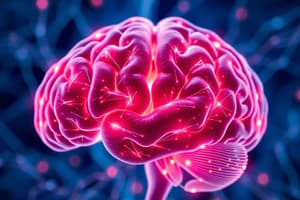Podcast
Questions and Answers
What is the location of the basal nuclei?
What is the location of the basal nuclei?
- Deep within the white matter of the cerebrum (correct)
- In the white matter of the cerebrum
- In the brain stem
- In the cerebral cortex
Which brain component is associated with functions such as regulation of many homeostatic functions?
Which brain component is associated with functions such as regulation of many homeostatic functions?
- Cerebral cortex
- Brain stem
- Hypothalamus (correct)
- Basal nuclei
Which of the following is NOT a function of the basal nuclei?
Which of the following is NOT a function of the basal nuclei?
- Coordination of slow, sustained movements
- Suppression of useless patterns of movements
- Inhibition of muscle tone
- Reception and integration of all synaptic input (correct)
What is the outer layer of gray matter in the cerebrum called?
What is the outer layer of gray matter in the cerebrum called?
Which brain component is involved in the regulation of muscle reflexes, equilibrium, and posture?
Which brain component is involved in the regulation of muscle reflexes, equilibrium, and posture?
What is the function of the cerebellum?
What is the function of the cerebellum?
What is the primary function of astrocytes in the CNS?
What is the primary function of astrocytes in the CNS?
What is the main function of oligodendrocytes in the CNS?
What is the main function of oligodendrocytes in the CNS?
What is the main function of microglia in the CNS?
What is the main function of microglia in the CNS?
What percentage of CNS cells are glial cells?
What percentage of CNS cells are glial cells?
What is the function of ependymal cells lining the ventricles?
What is the function of ependymal cells lining the ventricles?
What protects the CNS from external injury?
What protects the CNS from external injury?
Which lobe receives somesthetic and proprioceptive input from a specific body area?
Which lobe receives somesthetic and proprioceptive input from a specific body area?
What is the function of the Primary motor cortex in the Frontal lobe?
What is the function of the Primary motor cortex in the Frontal lobe?
Which structure separates the Frontal lobe and the Parietal lobe?
Which structure separates the Frontal lobe and the Parietal lobe?
What is the characteristic of the mapping of somatotopic areas in the brain?
What is the characteristic of the mapping of somatotopic areas in the brain?
What is the function of the Occipital lobe?
What is the function of the Occipital lobe?
What is the characteristic of the brain in terms of its structure and function?
What is the characteristic of the brain in terms of its structure and function?
Flashcards are hidden until you start studying
Study Notes
Brain Regions and Functions
- Occipital lobe: initial processing of visual input
- Temporal lobe: integration of all sensory input
- Parietal lobe: somatosensory processing, receives somesthetic and proprioceptive input from a specific body area
- Frontal lobe: voluntary motor activity, speaking ability, and elaboration of thought
Somatosensory Processing
- Parietal lobe receives most input from the opposite body side
- Each region of its cortex receives somesthetic and proprioceptive input from a specific body area
- The mapping of somatotopic areas varies slightly between individuals and is in a dynamic steady state
- These areas are influenced by use-dependent competition and modified by experience
Brain Components and Functions
- Cerebral cortex: highly convoluted, outer layer of gray matter
- Basal nuclei: located deep within the white matter, involved in various functions
- Thalamus: relay station for all synaptic input, crude awareness of sensation, some degree of consciousness, and role in motor control
- Hypothalamus: regulation of many homeostatic functions, such as temperature control, thirst, urine output, and food intake
- Cerebellum: maintenance of balance, enhancement of muscle tone, and coordination and planning of skilled voluntary muscle activity
- Brain stem: origin of majority of peripheral cranial nerves, cardiovascular, respiratory, and digestive control centers, and regulation of muscle reflexes involved with equilibrium and posture
Neurons and Glial Cells
- Interneuron: found entirely within the CNS, lies between afferent and efferent neurons
- Glial cells: about 90% of the CNS cells, do not send signals, support interneurons physically, metabolically, and functionally
- Four main kinds of glial cells: astrocytes, oligodendrocytes, microglia, and ependymal cells
- Astrocyte functions: holding neurons together, guiding neurons during development, establishing a blood-brain barrier, repairing brain injuries, and playing a role in neurotransmitter activity
- Oligodendrocyte function: forms myelin sheaths around axons in the CNS
- Microglia function: immune defense of the CNS, releases destructive chemicals against targets
- Ependymal cells function: lining the internal cavities of the CNS, helping form cerebrospinal fluid, and serving as neural stem cells
Studying That Suits You
Use AI to generate personalized quizzes and flashcards to suit your learning preferences.




